USGS Open-File Report 2005-1231
The statistical graphs of potassium, uranium, and thorium for the results of the classification of the data provide information about the quality and robustness of each class. This section discusses the statistical graphs for each of the classes. At strategic points within this section, links to subsections are provided to facilitate navigation within this section. Within each cluster of graphs, the graphs on the left are histograms and the graphs on the right are normal probability plots. Refer to the glossary for more information about each type of graph or view the information about interpreting them.
The figure below shows the graphs for class R01. The histogram of the potassium data is not symmetric and is truncated near 1.9 percent. The normal probability plot for potassium is curved which suggests that the distribution could not be represented by a normal distribution. The histogram of the uranium data is not symmetric but the normal probability plot is approximately linear from about 3 standard deviations below the mean to about 1.5 standard deviations above the mean. The thorium histogram is also not symmetric and exhibits a bimodal characteristic. The thorium normal probability plot has three distinct slope changes. Both of these results indicate that the thorium distribution is not a normal distribution. An examination of the classification map and the geologic map indicates that class R01 occurs mostly in areas mapped as units of the Beaumont Formation (Qb, Qbf, and Qbm). The fact that scattered areas classified as R01 occur within areas mapped as other geologic units suggest that the class is not completely robust and such areas may be incorrectly classified.
[R02] [R03] [R04] [R05] [R06] [R07] [R08] [R09] [R10] [R11] [R12] [R13] [R14] [R15] [R16] [R17] [R18] [R19] [R20] [R21]
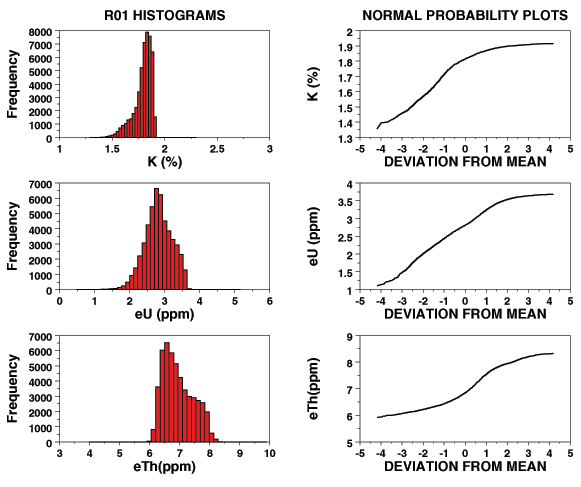
Figure R1. Histograms and probability graphs of potassium (K), uranium (eU), and thorium (eTh) concentrations of grid cells classified as class R01.
The figure below shows the graphs for class R02. The potassium histogram is approximately symmetric but cannot be represented by a normal distribution and the normal probability curve clearly indicates that. The uranium and thorium histograms are asymmetric. The normal probability plots for uranium indicate that the uranium distributions could be represented by a normal distribution but the thorium distribution cannot. An examination of the classification map and the geologic map indicates that class R02 occurs almost exclusively in areas mapped as recent floodplain deposits (Qas and Qam).
[R01] [R03] [R04] [R05] [R06] [R07] [R08] [R09] [R10] [R11] [R12] [R13] [R14] [R15] [R16] [R17] [R18] [R19] [R20] [R21]
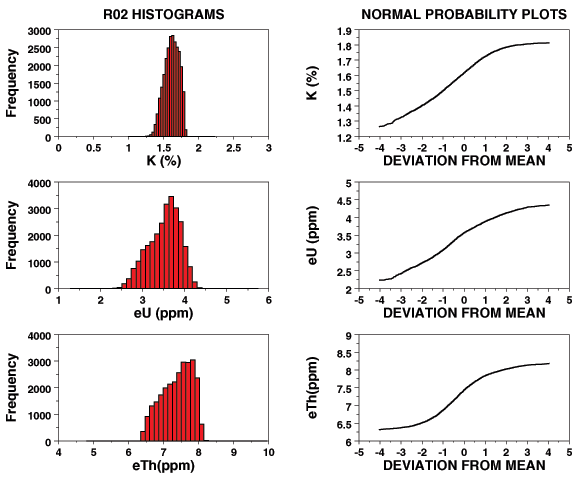
Figure R2. Histograms and probability graphs of potassium (K), uranium (eU), and thorium (eTh) concentrations of grid cells classified as class R02.
The figure below shows the graphs for class R03. All three histograms are asymmetric with some indications that the distributions are bimodal and the normal probability plots exhibit curvature. Comparison of the classification map and the geologic map shows that class R03 occurs mostly in areas mapped as members of the Beaumont Formation (Qb, Qbf, and Qbm).
[R01] [R02] [R04] [R05] [R06] [R07] [R08] [R09] [R10] [R11] [R12] [R13] [R14] [R15] [R16] [R17] [R18] [R19] [R20] [R21]
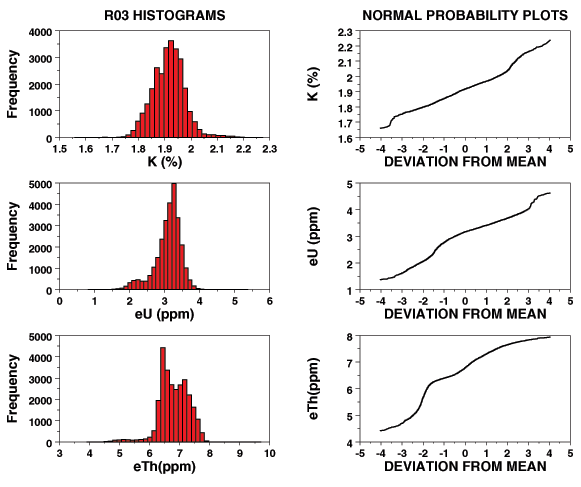
Figure R3. Histograms and probability graphs of potassium (K), uranium (eU), and thorium (eTh) concentrations of grid cells classified as class R03.
The figure below shows the graphs for class R04. All of the histograms are asymmetric and the thorium histogram has a small bimodal component. All of the normal probability plots exhibit some curvature although the uranium normal probability curve is approximately linear for much of the curve and could be used to calculate a normal distribution. The potassium and thorium distributions cannot be well represented by a normal distribution. Comparison of the classification map and the geologic map shows that class R04 occurs almost exclusively in areas mapped as Goliad Formation (Tg).
[R01] [R02] [R03] [R05] [R06] [R07] [R08] [R09] [R10] [R11] [R12] [R13] [R14] [R15] [R16] [R17] [R18] [R19] [R20] [R21]
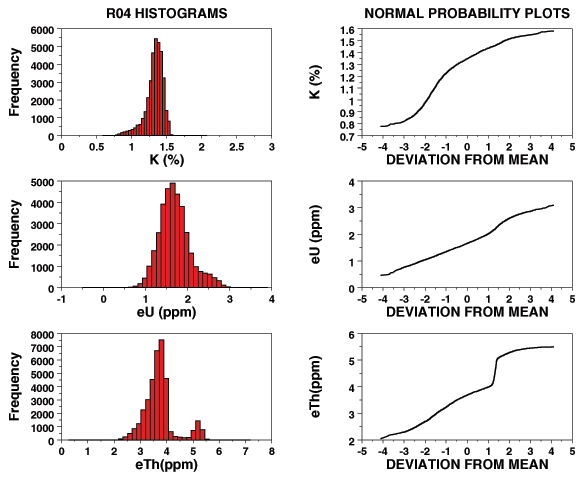
Figure R4. Histograms and probability graphs of potassium (K), uranium (eU), and thorium (eTh) concentrations of grid cells classified as class R04.
The figure below shows the graphs for class R05. The potassium histogram is asymmetric and the uranium and thorium histograms are approximately symmetric. The normal probability curves all have some curvature although the uranium and thorium graphs are approximately linear for most of the data. The potassium and thorium distributions cannot be well represented as normal distributions but the uranium distributions could be so represented. An examination of the classification map and the geologic map indicates that class R05 occurs within areas mapped as dune sand (qds), Goliad Formation (Tg), and Lissie Formation (Ql).
[R01] [R02] [R03] [R04] [R06] [R07] [R08] [R09] [R10] [R11] [R12] [R13] [R14] [R15] [R16] [R17] [R18] [R19] [R20] [R21]
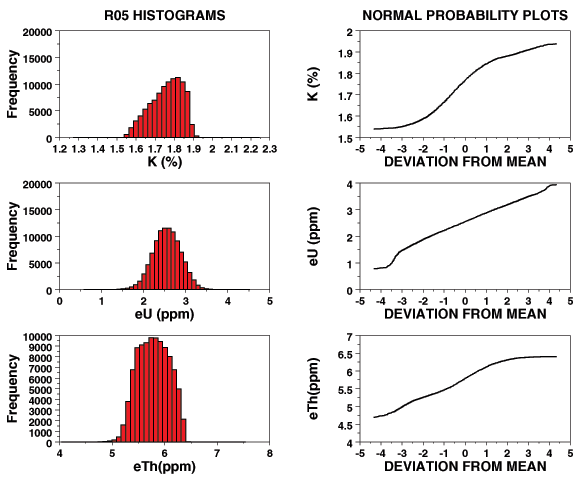
Figure R5. Histograms and probability graphs of potassium (K), uranium (eU), and thorium (eTh) concentrations of grid cells classified as class R05.
The figure below shows the graphs for class R06. The potassium histogram is asymmetric and the uranium and thorium histograms are approximately symmetric. The potassium normal probability plot exhibits curvature and slope changes that indicate that a normal distributions would not provide a good fit to the distribution. The uranium and thorium normal probability plots are approximately linear and normal distributions could be used to represent the distributions. An examination of the classification map and the geologic map shows that class R06 occurs mostly in areas mapped as members of the Beaumont Formation (Qb, Qbf, and Qbm).
[R01] [R02] [R03] [R04] [R05] [R07] [R08] [R09] [R10] [R11] [R12] [R13] [R14] [R15] [R16] [R17] [R18] [R19] [R20] [R21]
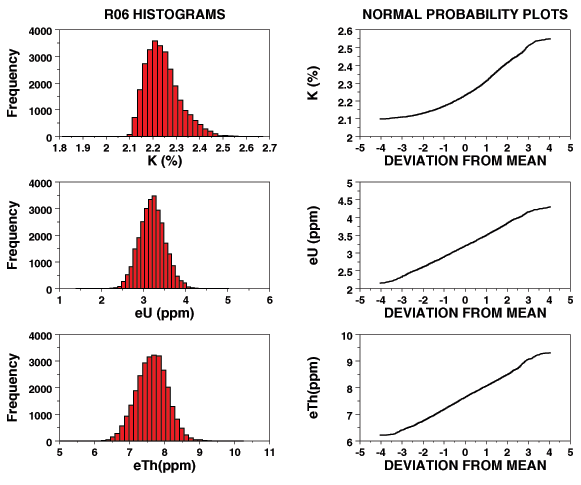
Figure R6. Histograms and probability graphs of potassium (K), uranium (eU), and thorium (eTh) concentrations of grid cells classified as class R06.
The figure below shows the graphs for class R07. The histograms for all three elements are approximately symmetric but the normal probability graphs have curvature that agues against the use of normal distributions to represent the distributions. Comparison of the classification map and the geologic map shows that class R07 occurs almost exclusively in areas mapped as recent floodplain deposits (Qas and Qam).
[R01] [R02] [R03] [R04] [R05] [R06] [R08] [R09] [R10] [R11] [R12] [R13] [R14] [R15] [R16] [R17] [R18] [R19] [R20] [R21]
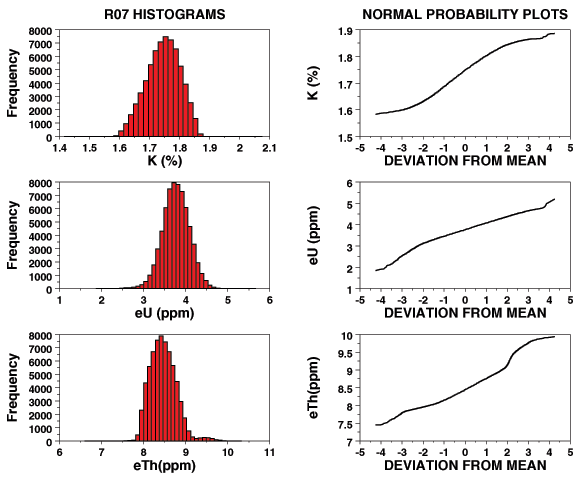
Figure R7. Histograms and probability graphs of potassium (K), uranium (eU), and thorium (eTh) concentrations of grid cells classified as class R07.
The figure below shows the graphs for class R08. All of the histograms are approximately symmetric but only the uranium normal probability plot supports the use of a normal distribution to represent the distribution. Comparison of the classification map and the geologic map indicates that class R08 occurs mostly in areas mapped as members of the Beaumont Formation (Qb, Qbf, and Qbm).
[R01] [R02] [R03] [R04] [R05] [R06] [R07] [R09] [R10] [R11] [R12] [R13] [R14] [R15] [R16] [R17] [R18] [R19] [R20] [R21]
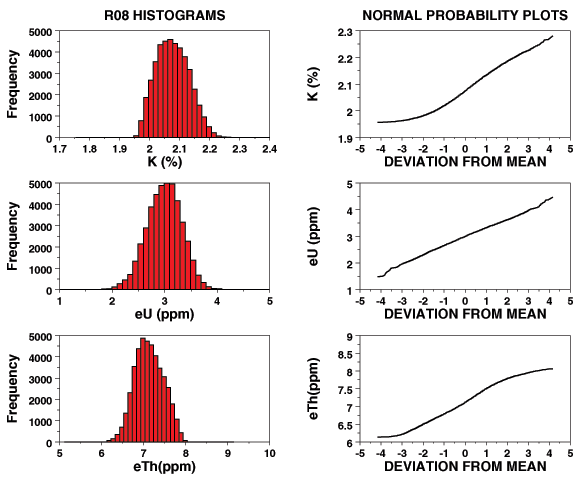
Figure R8. Histograms and probability graphs of potassium (K), uranium (eU), and thorium (eTh) concentrations of grid cells classified as class R08.
The figure below shows the graphs for class R09. The potassium histogram is bimodal and the normal probability plot supports the conclusion that a normal distribution would be a poor fit to the potassium distribution. The uranium histogram appears to be symmetric but the normal probability plot is curved indicating that a normal distribution could not be used to represent the data. The thorium histogram is also skewed but the normal probability plot is approximately linear indicating that a normal distribution could be used to represent the data. An examination of the classification map and the geologic map reveals that class R09 occurs almost exclusively in areas mapped as recent floodplain deposits (Qas and Qam).
[R01] [R02] [R03] [R04] [R05] [R06] [R07] [R08] [R10] [R11] [R12] [R13] [R14] [R15] [R16] [R17] [R18] [R19] [R20] [R21]
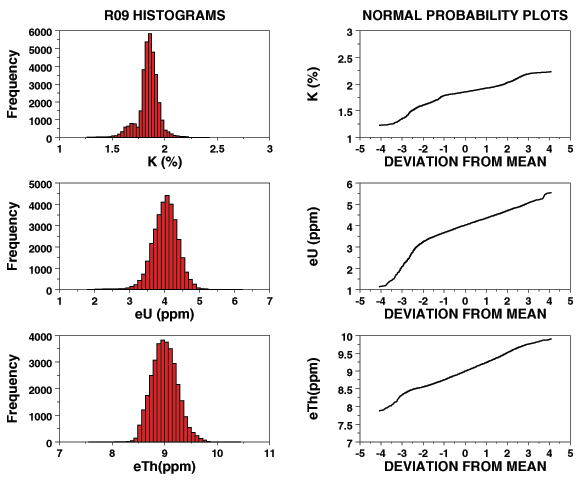
Figure R9. Histograms and probability graphs of potassium (K), uranium (eU), and thorium (eTh) concentrations of grid cells classified as class R09.
The figure below shows the graphs for class R10. The potassium and thorium histograms are asymmetric and the uranium histogram is approximately symmetric. The potassium normal probability graph does not support using a normal distribution to represent the potassium distribution. The uranium and thorium normal probability plots are approximately linear indicating that normal distributions would provide reasonable fits to the data. An examination of the classification map and the geologic map indicates that class R10 occurs almost exclusively in areas mapped as recent floodplain deposits (Qas and Qam).
[R01] [R02] [R03] [R04] [R05] [R06] [R07] [R08] [R09] [R11] [R12] [R13] [R14] [R15] [R16] [R17] [R18] [R19] [R20] [R21]
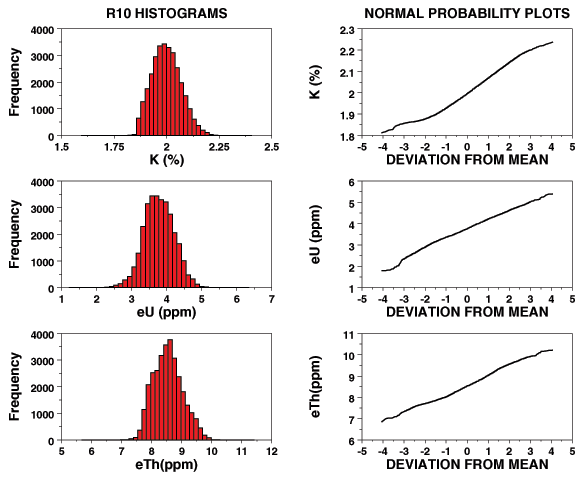
Figure R10. Histograms and probability graphs of potassium (K), uranium (eU), and thorium (eTh) concentrations of grid cells classified as class R10.
The figure below shows the graphs for class R11. The potassium and thorium histograms appear to be approximately symmetric but the corresponding normal probability graphs do not support the use of normal distributions to represent the data. The uranium histogram is asymmetric and the uranium normal probability plot indicates that a normal distribution cannot be used to represent the data. Comparison of the classification map and the geologic map indicates that class R11 occurs mostly in areas mapped as members of the Beaumont Formation (Qb, Qbf, and Qbm).
[R01] [R02] [R03] [R04] [R05] [R06] [R07] [R08] [R09] [R10] [R12] [R13] [R14] [R15] [R16] [R17] [R18] [R19] [R20] [R21]
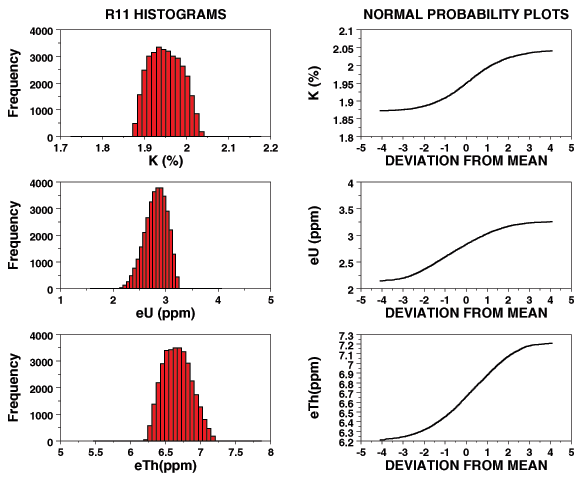
Figure R11. Histograms and probability graphs of potassium (K), uranium (eU), and thorium (eTh) concentrations of grid cells classified as class R11.
The figure below shows the graphs for class R12. All of the histograms are asymmetric and the associated normal probability plots have a lot of curvature indicating that normal distributions would not provide good fits to the data. Comparison of the classification map and the geologic map indicates that class R11 occurs mostly in areas where ponds and lakes are present.
[R01] [R02] [R03] [R04] [R05] [R06] [R07] [R08] [R09] [R10] [R11] [R13] [R14] [R15] [R16] [R17] [R18] [R19] [R20] [R21]
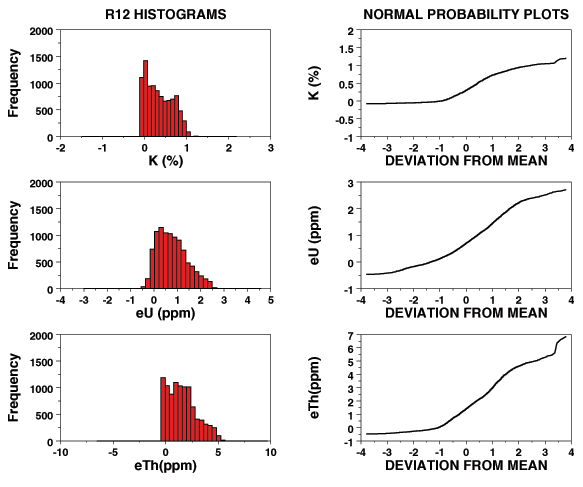
Figure R12. Histograms and probability graphs of potassium (K), uranium (eU), and thorium (eTh) concentrations of grid cells classified as class R12.
The figure below shows the graphs for class R13. The potassium and thorium histograms are asymmetric and the normal probability plots do not support using normal distributions to model the data. The uranium histogram is approximately symmetric and the normal probability plot is reasonably linear indicating that a normal distribution could be used to represent the uranium distribution. An examination of the classification map and the geologic map indicates that class R13 occurs in areas mapped as members of the Beaumont Formation (Qb, Qbf, and Qbm), dune sand (Qds), and Lissie Formation (Ql).
[R01] [R02] [R03] [R04] [R05] [R06] [R07] [R08] [R09] [R10] [R11] [R12] [R14] [R15] [R16] [R17] [R18] [R19] [R20] [R21]
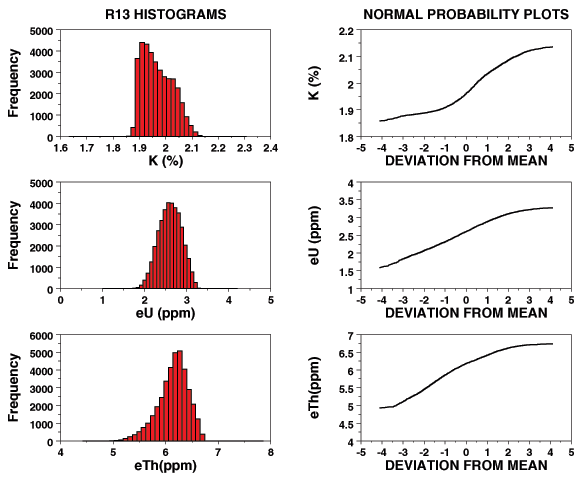
Figure R13. Histograms and probability graphs of potassium (K), uranium (eU), and thorium (eTh) concentrations of grid cells classified as class R13.
The figure below shows the graphs for class R14. The potassium and uranium histograms are approximately symmetric and the thorium histogram is somewhat asymmetric. The potassium normal probability plot exhibits curvature indicating that a normal distribution would not fit the data. The uranium and thorium normal probability graphs are roughly linear indicating that normal distributions would provide reasonable fits to the data. An examination of the classification map and the geologic map indicates that class R10 occurs mostly in areas mapped as recent floodplain deposits (Qas and Qam).
[R01] [R02] [R03] [R04] [R05] [R06] [R07] [R08] [R09] [R10] [R11] [R12] [R13] [R15] [R16] [R17] [R18] [R19] [R20] [R21]
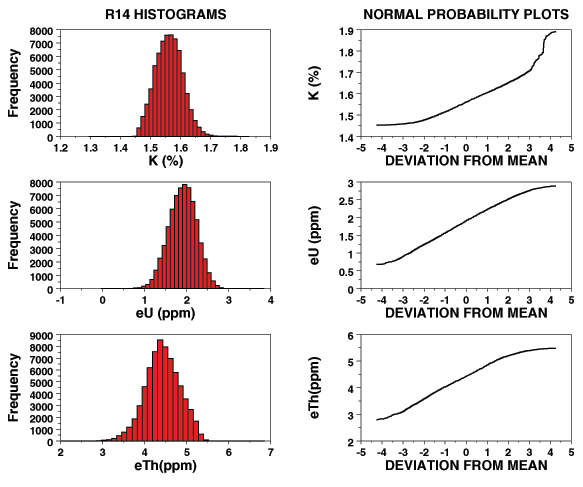
Figure R14. Histograms and probability graphs of potassium (K), uranium (eU), and thorium (eTh) concentrations of grid cells classified as class R14.
The figure below shows the graphs for class R15. For all three elements the histograms are somewhat asymmetric although the normal probability plots are roughly linear and normal distributions could be used to represent the distributions. An examination of the classification map and the geologic map shows that class R15 occurs almost exclusively in areas mapped as recent floodplain deposits (Qas and Qam).
[R01] [R02] [R03] [R04] [R05] [R06] [R07] [R08] [R09] [R10] [R11] [R12] [R13] [R14] [R16] [R17] [R18] [R19] [R20] [R21]
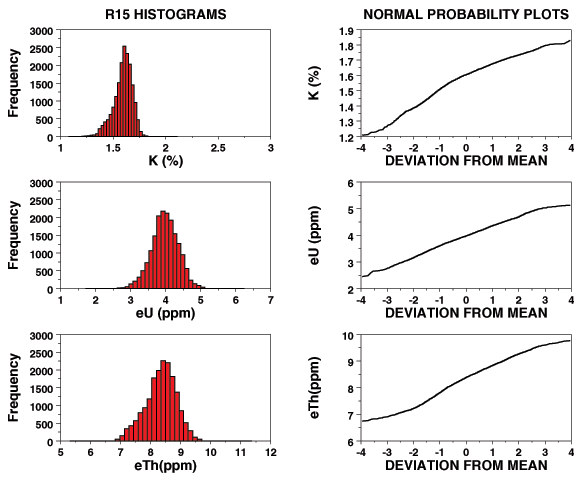
Figure R15. Histograms and probability graphs of potassium (K), uranium (eU), and thorium (eTh) concentrations of grid cells classified as class R15.
The figure below shows the graphs for class R16. The potassium and thorium histograms are asymmetric with a lot of curvature in the corresponding normal probability plots indicating that normal distributions would not fit the data. The uranium histogram is approximately symmetric and the normal probability plot is generally linear indicating that a normal distribution would provide a good fit to the data. Comparison of the classification map and the geologic map shows that class R16 occurs mostly in areas mapped as dunes sands (Qds) or Goliad Formation (Tg).
[R01] [R02] [R03] [R04] [R05] [R06] [R07] [R08] [R09] [R10] [R11] [R12] [R13] [R14] [R15] [R17] [R18] [R19] [R20] [R21]
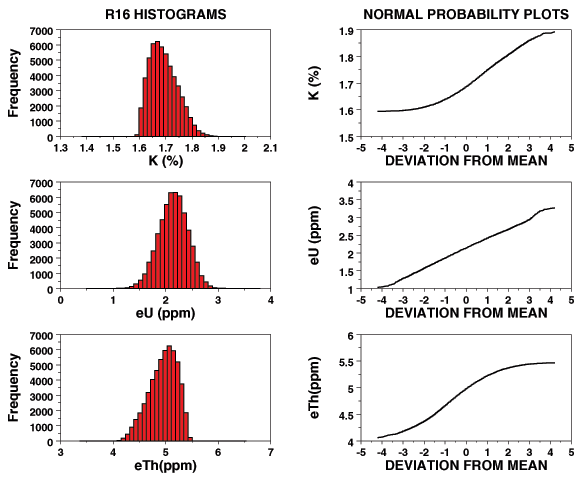
Figure R16. Histograms and probability graphs of potassium (K), uranium (eU), and thorium (eTh) concentrations of grid cells classified as class R16.
The figure below shows the graphs for class R17. The potassium and thorium histograms are asymmetric but the corresponding normal probability plots are approximately linear indicating that normal distributions could be used to model the data. The uranium histogram is approximately symmetric and the normal probability plot is generally linear indicating that a normal distribution would provide a good fit to the data. Comparison of the classification map and the geologic map shows that class R17 occurs mostly in areas mapped as dune sands (Qds) or Goliad Formation (Tg).
[R01] [R02] [R03] [R04] [R05] [R06] [R07] [R08] [R09] [R10] [R11] [R12] [R13] [R14] [R15] [R16] [R18] [R19] [R20] [R21]
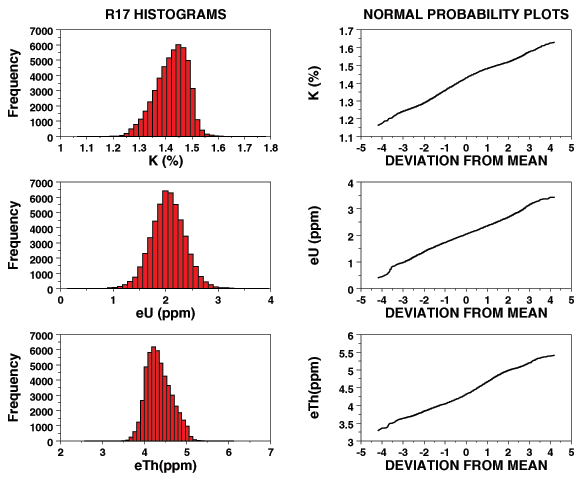
Figure R17. Histograms and probability graphs of potassium (K), uranium (eU), and thorium (eTh) concentrations of grid cells classified as class R17.
The figure below shows the graphs for class R18. For all three elements the histograms are asymmetric. All of the normal probability plots are curved and normal distributions could not be used to represent the distributions. An examination of the classification map and the geologic map shows that class R18 occurs almost exclusively in areas mapped as recent floodplain deposits (Qas and Qam).
[R01] [R02] [R03] [R04] [R05] [R06] [R07] [R08] [R09] [R10] [R11] [R12] [R13] [R14] [R15] [R16] [R17] [R19] [R20] [R21]
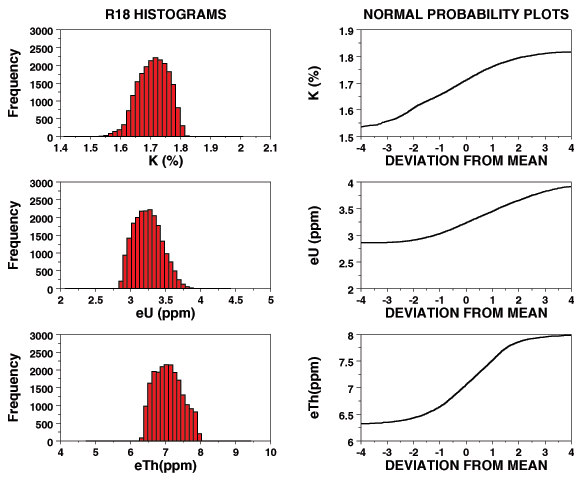
Figure R18. Histograms and probability graphs of potassium (K), uranium (eU), and thorium (eTh) concentrations of grid cells classified as class R18.
The figure below shows the graphs for class R19. For all three elements the histograms are asymmetric. All of the normal probability plots exhibit curvature indicating that normal distributions cannot be used to represent the distributions. Comparison of the classification map and the geologic map shows that class R19 occurs mostly in areas mapped as members of the Beaumont Formation (Qb, Qbf, and Qbm). Examination of the map showing areas where the survey aircraft flew at effective altitudes greater than 200 m reveals that much of the area of class R19 occurs in those areas. An interesting relationship is that grid cells classified as R19 often occur around areas classified as class R12.
[R01] [R02] [R03] [R04] [R05] [R06] [R07] [R08] [R09] [R10] [R11] [R12] [R13] [R14] [R15] [R16] [R17] [R18] [R20] [R21]
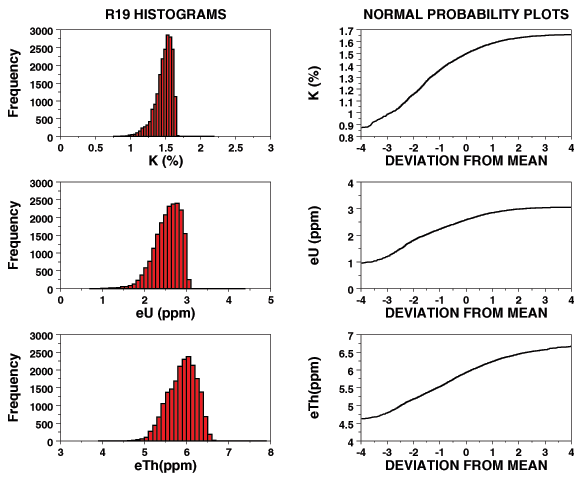
Figure R19. Histograms and probability graphs of potassium (K), uranium (eU), and thorium (eTh) concentrations of grid cells classified as class R19.
The figure below shows the graphs for class R20. For all three elements the histograms are asymmetric. All of the normal probability plots exhibit curvature indicating that normal distributions cannot be used to represent the distributions. Comparison of the classification map and the geologic map shows that class R20 occurs mostly in areas mapped as members of the Beaumont Formation (Qb, Qbf, and Qbm). Examination of the map showing areas where the survey aircraft flew at effective altitudes greater than 200 m reveals that much of the area of class R20 occurs in those areas. An interesting relationship is that grid cells classified as R20 often occur around areas classified as class R12.
[R01] [R02] [R03] [R04] [R05] [R06] [R07] [R08] [R09] [R10] [R11] [R12] [R13] [R14] [R15] [R16] [R17] [R18] [R19] [R21]
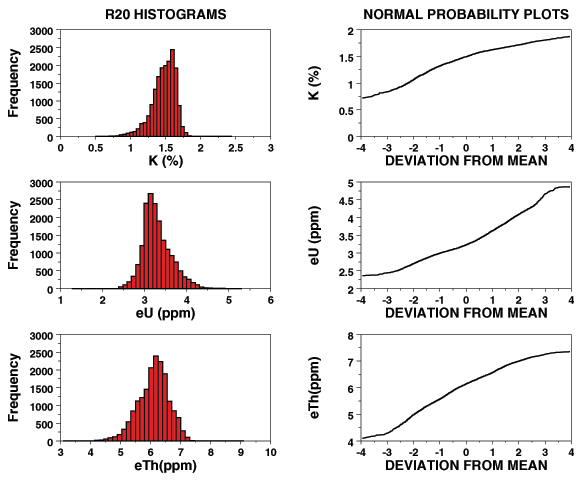
Figure R20. Histograms and probability graphs of potassium (K), uranium (eU), and thorium (eTh) concentrations of grid cells classified as class R20.
The figure below shows the graphs for class R21. For all three elements the histograms are approximately symmetric but all of the normal probability plots exhibit curvature indicating that normal distributions could not be used to represent the distributions. An examination of the classification map and the geologic map shows that class R21 occurs almost exclusively in areas mapped as recent floodplain deposits (Qas and Qam).
[R01] [R02] [R03] [R04] [R05] [R06] [R07] [R08] [R09] [R10] [R11] [R12] [R13] [R14] [R15] [R16] [R17] [R18] [R19] [R20]
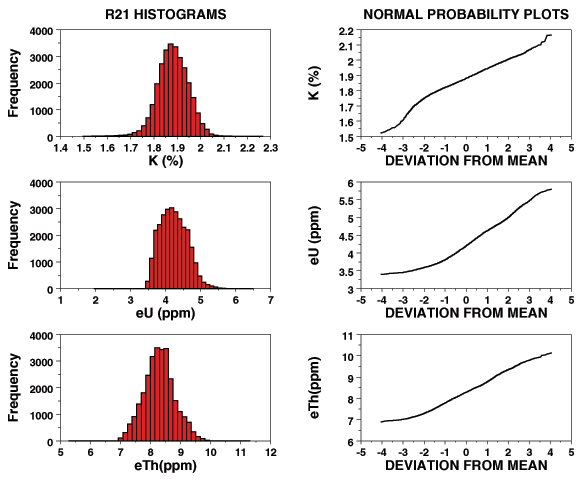
Figure R21. Histograms and probability graphs of potassium (K), uranium (eU), and thorium (eTh) concentrations of grid cells classified as class R21.
![]() Geology Comparisons | Comparison Histograms
Geology Comparisons | Comparison Histograms ![]()